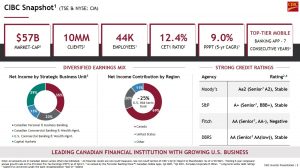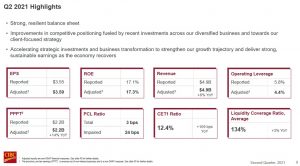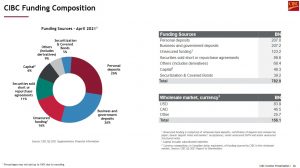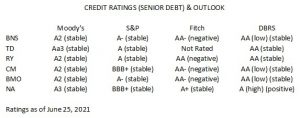Contents
In this CIBC Stock Analysis, I look at whether The Canadian Imperial Bank of Commerce is currently an attractive investment opportunity.
NOTE: (CIBC) reports in Canadian dollars and is listed on the TSX and the NYSE. All financial information in this post is expressed in Canadian dollars.
Information Sources
The following are links to a few of my sources to aid in your own analysis.
The 'Management discussion and analysis' section within CM's 2020 Annual Report is extensive but contains a comprehensive overview of the bank's businesses, customers, business strategy, solutions and risks. Additional information is also available in the:
- Q2 2021 Report to Shareholders;
- Q2 2021 Earnings Presentation;
- May 27, 2021 Investor Presentation; and
- Q2 2021 Fixed Income Investor Presentation.
CIBC - Stock Analysis - Business Overview
The following image provides a high-level snapshot of CM.
CM's 3 strategic priorities are:
- Reinvigorate the Canadian consumer franchise;
- Protect and build on areas of strength; and
- Accelerate the pace of transformation and growth.
It has four Strategic Business Units (SBUs):
- Canadian Personal and Business Banking;
- Canadian Commercial Banking and Wealth Management;
- US Commercial Banking and Wealth Management; and
- Capital Markets.
These SBUs are supported by the functional groups which form part of Corporate and Other.
- Technology
- Infrastructure and Innovation
- Risk Management
- People
- Culture
- Brand
- Finance and Enterprise Strategy
Corporate and Other also includes the results of CIBC FirstCaribbean and other strategic investments, as well as other income statement and balance sheet items not directly attributable to the business lines.
On November 8, 2019, CM announced it had entered into a definitive agreement to sell 66.73% of the outstanding shares of FirstCaribbean International Bank Limited (CIBC FirstCaribbean) to GNB Financial Group Limited (GNB), subject to regulatory approvals. As a result of:
- the lengthy regulatory review process;
- the worsening impact of the COVID-19 pandemic on the Caribbean economy; and
- CM's revised expectations concerning the likelihood and timing of a potential transaction
a decision was made to discontinue the application for the sale of CIBC FirstCaribbean. In Q4 2020, the bank recorded a goodwill impairment charge of $0.22B. Furthermore, on February 3, 2021, CM announced that the proposed sale of CIBC FirstCaribbean to GNB did not receive approval from CIBC FirstCaribbean’s regulators.
CIBC - Continually Challenged
I started working in the Canadian banking sector in 1980 and retired early in 2016. During my entire banking career, CM was rarely at a loss of ways to incur billions of dollars in losses. If it wasn't:
- losses related to Global Crossing when the .com bubble burst;
- losses related to the U.S. residential mortgage market; or
- a public relations disaster when it had to compensate clients ~$73.33 million after collecting excess fees for certain mutual funds and investment services over 14 years
it was something else.
In early 2020, CM had to make major changes to its senior executive ranks to improve results from its underperforming retail banking division. Furthermore, CM was under mounting pressure from investors to get a better grip on rising expenses and to jump-start growth in its mortgage lending which is a key source of revenue that stalled for roughly a year.
As much as senior management may claim things are improving, I think investors would be well advised to expect another 'shoe to fall' in the coming years. It is just in CM's DNA.
CIBC - Stock Analysis - Financials
Q2 and YTD 2021 Results
We see from CM's Q2 and YTD 2021 Financial Highlights that the strong balance sheet provides it with the capacity and flexibility to support its clients, grow the business and return capital to shareholders.
Additional information is accessible here.
CIBC - Stock Analysis - Credit Ratings
The banks which found themselves in dire straits when The Financial Crisis hit were those with a heavy reliance on wholesale funding.
Wholesale funding uses a variety of commercial credit markets including federal funds and brokered deposits by lenders. It can work well but can be more expensive than traditional routes and this method of funding carries unique risks and considerations.
I distinctly remember Bear Stearns urgently requesting the immediate return of significant overnight deposits held with my employer to stave off its collapse. My employer did not rely on these overnight deposits but Bear Stearns most certainly did and we all know what happened to Bear Stearns!
A well-established bank, such as CIBC, has a strong capital base and it also has a large base of customer deposits. This reduces the bank's reliance on wholesale funding thus lowering investor risk.
My investor profile is such that I do not speculate and I pay close attention to risk. As an equity investor, I know my risk is far greater than that of debt holders. I, therefore, invest primarily in companies whose long-term unsecured debt is investment grade.
The major rating agencies assign the following ratings to the Senior Debt of Canada's major banks.
In looking at CM's senior domestic debt ratings going back to 2010 (refer to the Annual Reports), we see a slight deterioration in some of the assigned ratings.
- 2010 Annual Report, Moody's, S&P, Fitch, and DBRS assigned Aa2, A+, AA-, and AA ratings.
- 2014 Annual Report, Moody's, S&P, Fitch, and DBRS assigned Aa3, A+, AA-, and AA ratings.
- 2018 Annual Report, Moody's, S&P, Fitch, and DBRS assigned A2, BBB+, AA-, and AA (low) ratings.
- 2019 Annual Report, Moody's, S&P, Fitch, and DBRS assigned A2, BBB+, AA-, and AA (low) ratings.
Although the ratings differ slightly, all the ratings reflected above are investment grade. These ratings, in essence, define the banks as having a STRONG capacity to meet their financial commitments. The banks, however, are somewhat more susceptible to the adverse effects of changes in circumstances and economic conditions than obligors in higher-rated categories.
Despite the deterioration in some of the ratings over the years, CM's ratings are still acceptable for my risk tolerance.
Dividend and Dividend Yield
Looking at CM's dividend history, we see regular increases with the periodic interruptions. Following the October 29, 2007 $0.87 dividend, there were no increases until the October 28, 2011 $0.90 dividend. CM was not unique in this regard as the other major Canadian banks also froze their dividends.
CM's current $1.46 quarterly dividend was first distributed April 28, 2020 and there has been no change since such time. With the onset of COVID-19 in Canada, OSFI suspended share buybacks and dividend increases by Canadian banks and insurers in March 2020. This was part of a raft of measures intended to gird against the economic impact of the COVID-19 pandemic.
Although OSFI believes there may be exceptional circumstances where a non-recurring payment of special, or irregular, dividends may be acceptable, there is no immediate plan to lift the broad freeze.
To qualify for exceptional circumstances:
- a firm’s capital and liquidity must remain strong following the payout;
- the special dividend should be limited to a special business objective and not be distributed to a broad group of shareholders.
The major Canadian banks have very strong capital ratios and could increase their dividend or distribute a 'special dividend. OSFI, however, indicates there remains too much uncertainty to change its expectation on regular dividends. Current conditions are stable but the financial impacts of the COVID-19 pandemic are yet to be fully realized.
Despite the significant increase in CM's share price subsequent to the March 2020 low (~ low $70s), the current $5.84 annual dividend yields ~4.1% on the basis of the current ~$141.50 share price.
The bank is well-capitalized and its YTD adjusted dividend payout ratio is ~40.7%. This places it in a position to resume regular dividend increases or to distribute a 'special' dividend once OSFI permits this.
CM's FY2011 - 2020 weighted average diluted issued and outstanding shares (in millions) is 407, 404, 401, 398, 398, 396, 414, 445, 445, and 446. The figure as of the end of Q2 2021 (April 30) is ~449.3.
According to a Bloomberg Intelligence study, the Canadian banks could repurchase ~2% - ~5% of their outstanding shares in FY2021 if OSFI permits purchases in a similar manner to what the U.S. Federal Reserve permitted late 2020 for American banks.
While the economic and market disruptions stemming from the pandemic have abated and banks’ capital levels have been resilient, some “key vulnerabilities” remain in the economy, including elevated household and corporate debts
As noted earlier in this post, the current real estate market conditions in Canada have led to high household indebtedness and imbalances in the housing market. These vulnerabilities have intensified over the past year.
Although CM could distribute a 'special dividend' or increase its quarterly dividend to reduce its excess capital, CM could also entertain acquisitions or share repurchases. Naturally, CM requires OSFI's approval but OSFI likely wants to proceed cautiously to ascertain the severity of credit losses; I do not expect OSFI to render a decision on share repurchases and dividend increases until late 2021.
CIBC - Stock Analysis - Valuation
CM's YTD adjusted diluted EPS is $7.17 and adjusted diluted EPS guidance from 14 brokers for FY2021 and 13 brokers for FY2022 is fairly wide-ranging.
- FY2021 adjusted diluted EPS is a mean of $13.86 and a $12.92 - $15.39 range. With shares trading at ~$141.50, the forward adjusted diluted PE is ~10.21 using the mean value.
- FY2022 adjusted diluted EPS is a mean of $13.65 and a $13 - $15.01 range. With shares trading at ~$141.50, the forward adjusted diluted PE is ~10.37 using the mean value.
This level is within a reasonable range of the forward adjusted diluted PE of CM's peers; RY and TD are marginally higher.
Regrettably, CM's share price has appreciated considerably over the last few months. They are, in my opinion, no longer a 'bargain'. If, however, you are a long-term shareholder and periodically acquire additional shares on weakness, then an investment in CM at the current valuation should generate a reasonably attractive return.
CIBC - Stock Analysis - Final Thoughts
I do not dispute CM's credit ratings, valuation, and dividend yield are acceptable. However, while TD's and RY's dividend yield and valuation are slightly inferior to that of CM, the quality of these two banks is far, far superior to that of CM.
CM, in my opinion, is always an accident waiting to happen. Despite this, I know some investors will find CM to be an enticing investment. Given this, it is worth noting that in order to receive the July 28th $1.46 dividend, an investor would have to be a shareholder of record on June 28th. If you are not an existing CM shareholder, the next dividend record date is September 28th and the dividend distribution date is October 28th. You must already own shares at least two days before the dividend record date to be eligible for payment of stock dividends; this is one day before the ex-dividend date.
Stay safe. Stay focused.
I wish you much success on your journey to financial freedom!
Note: Please send any feedback, corrections, or questions to [email protected].
Disclosure: I am long CM, BMO, RY, TD, and BNS.
Disclaimer: I do not know your individual circumstances and do not provide individualized advice or recommendations. I encourage you to make investment decisions by conducting your own research and due diligence. Consult your financial advisor about your specific situation.







